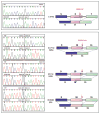Contribution of inherited mutations in the BRCA2-interacting protein PALB2 to familial breast cancer
- PMID: 21285249
- PMCID: PMC3059378
- DOI: 10.1158/0008-5472.CAN-10-3958
Contribution of inherited mutations in the BRCA2-interacting protein PALB2 to familial breast cancer
Abstract
Inherited mutations in the BRCA2-interacting protein PALB2 are known to be associated with increased risks of developing breast cancer. To evaluate the contribution of PALB2 to familial breast cancer in the United States, we sequenced the coding sequences and flanking regulatory regions of the gene from constitutional genomic DNA of 1,144 familial breast cancer patients with wild-type sequences at BRCA1 and BRCA2. Overall, 3.4% (33/972) of patients not selected by ancestry and 0% (0/172) of patients specifically of Ashkenazi Jewish ancestry were heterozygous for a nonsense, frameshift, or frameshift-associated splice mutation in PALB2. Mutations were detected in both male and female breast cancer patients. All mutations were individually rare: the 33 heterozygotes harbored 13 different mutations, 5 previously reported and 8 novel mutations. PALB2 heterozygotes were 4-fold more likely to have a male relative with breast cancer (P = 0.0003), 6-fold more likely to have a relative with pancreatic cancer (P = 0.002), and 1.3-fold more likely to have a relative with ovarian cancer (P = 0.18). Compared with their female relatives without mutations, increased risk of developing breast cancer for female PALB2 heterozygotes was 2.3-fold (95% CI: 1.5-4.2) by age 55 and 3.4-fold (95% CI: 2.4-5.9) by age 85. Loss of the wild-type PALB2 allele was observed in laser-dissected tumor specimens from heterozygous patients. Given this mutation prevalence and risk, consideration might be given to clinical testing of PALB2 by complete genomic sequencing for familial breast cancer patients with wild-type sequences at BRCA1 and BRCA2.
©2011 AACR.
Figures



References
-
- National Comprehensive Cancer Network. NCCN clinical practice guidelines in oncology: breast cancer screening and diagnosis. J Natl Comp Cancer Network. 2009;7:1060–96. - PubMed
-
- Ashworth A. A synthetic lethal therapeutic approach: poly(ADP) ribose polymerase inhibitors for the treatment of cancers deficient in DNA double-strand break repair. J Clin Oncol. 2008;26:3785–90. - PubMed
-
- Fong PC, Boss DS, Yap TA, et al. Inhibition of poly(ADP-ribose) polymerase in tumors from BRCA mutation carriers. N Engl J Med. 2009;361:123–34. - PubMed
-
- Tutt A, Robson M, Garber JE, et al. Oral poly(ADP-ribose) polymerase inhibitor olaparib in patients with BRCA1 or BRCA2 mutations and advanced breast cancer: a proof-of-concept trial. Lancet. 2010;376:235–44. - PubMed
-
- Hollestelle A, Wasielewski M, Martens JW, Schutte M. Discovering moderate-risk breast cancer susceptibility genes. Curr Opin Genet Dev. 2010;20:268–76. - PubMed
Publication types
MeSH terms
Substances
Grants and funding
LinkOut - more resources
Full Text Sources
Other Literature Sources
Medical
Research Materials
Miscellaneous

